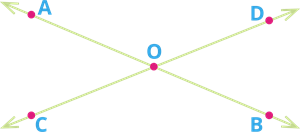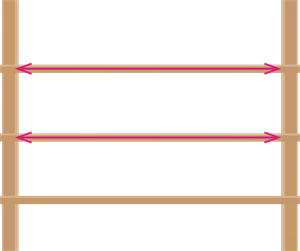
PUMPA - SMART LEARNING
எங்கள் ஆசிரியர்களுடன் 1-ஆன்-1 ஆலோசனை நேரத்தைப் பெறுங்கள். டாப்பர் ஆவதற்கு நாங்கள் பயிற்சி அளிப்போம்
Book Free DemoIntersecting lines:
When two lines cross each other and share a common point is known as the Intersecting line.

The above figure shows intersecting lines \(AB\) and \(CD\). Where two-line \(AB\) and \(CD\) intersect at a common point ‘\(O\)’.
Example:
We can see that the pair of metal blades in the scissor intersecting at a common point. There are many other day-to-day examples of this concept.

Parallel lines:
When two lines are in the same plane and will never intersect each other is known as Parallel lines.

The above figure shows parallel lines \(AB\) and \(CD\). Where two lines \(AB\) and \(CD\) are in the same plane but will never intersect each other and hence are termed as parallel lines.
Example:
We can see that the garage shelf parallel to each other. There are many other day-to-day examples for this idea.

Concurrent lines:
When set of lines are said to be concurrent lines if they all intersect at the same point.

The above figure shows the concurrent lines \(AB\), \(CD\), \(PQ\) and \(RS\) because they all intersect at a single point \(O\). Thus, the concurrency of point is \(O\).
Example:
We can see that the orange pulps insect each other at a point \(P\). There are many other day to day examples of this idea.

Perpendicular lines:
When they meet (or intersect), two lines are said to be perpendicular to each other, and the angle between them is a right angle, that is, \(90°\).

The above figure shows the perpendicular lines \(AB\) and \(CD\), and it is written as \(AB Ʇ CD\).
Example:
We can see that windowpane intersect a line at \(90°\). There are many other day-to-day examples for this idea.
